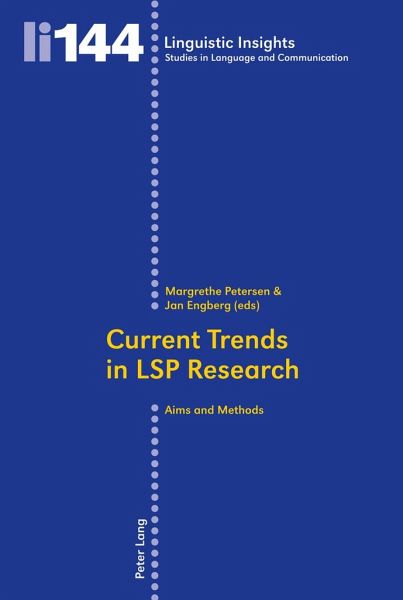
Current Trends in LSP Research
Aims and Methods
Herausgegeben: Petersen, Margrethe; Engberg, Jan
Versandkostenfrei!
Versandfertig in 6-10 Tagen
88,75 €
inkl. MwSt.

PAYBACK Punkte
0 °P sammeln!
This volume offers an overview of new perspectives and ongoing developments in research on Language for Specific Purposes (LSP) and specialised discourse. Traditionally investigated on the basis of terminology and genre studies, the area now also draws on such diverse fields as sociolinguistics, sociology, psychology and communication studies. This widening range of perspectives increases the need for insights into and knowledge about current developments in research on LSP and specialised discourse. The chapters included here have been selected to address this need. Based on papers presented ...
This volume offers an overview of new perspectives and ongoing developments in research on Language for Specific Purposes (LSP) and specialised discourse. Traditionally investigated on the basis of terminology and genre studies, the area now also draws on such diverse fields as sociolinguistics, sociology, psychology and communication studies. This widening range of perspectives increases the need for insights into and knowledge about current developments in research on LSP and specialised discourse.
The chapters included here have been selected to address this need. Based on papers presented at the XVII European LSP Symposium, they reflect its focus: aims and methods in current research on LSP and specialised discourse. Two chapters present the research history of the area, its current status, and emergent issues. Nine chapters exemplify methods currently applied, new aims pursued, or new aims supported by innovative methods. The methods include discourse analysis, use of specialist informants, study of multimedia texts, sociological observation, interviews, etc. The aims vary from unveiling politicians' linguistic representation of the 2008 financial meltdown over inclusion of visual representations in LSP research to clarifying the limits of lay understanding of specialised knowledge. In sum, the volume offers the reader a holistic, yet multi-faceted overview of state-of-the-art research in this area.
The chapters included here have been selected to address this need. Based on papers presented at the XVII European LSP Symposium, they reflect its focus: aims and methods in current research on LSP and specialised discourse. Two chapters present the research history of the area, its current status, and emergent issues. Nine chapters exemplify methods currently applied, new aims pursued, or new aims supported by innovative methods. The methods include discourse analysis, use of specialist informants, study of multimedia texts, sociological observation, interviews, etc. The aims vary from unveiling politicians' linguistic representation of the 2008 financial meltdown over inclusion of visual representations in LSP research to clarifying the limits of lay understanding of specialised knowledge. In sum, the volume offers the reader a holistic, yet multi-faceted overview of state-of-the-art research in this area.












